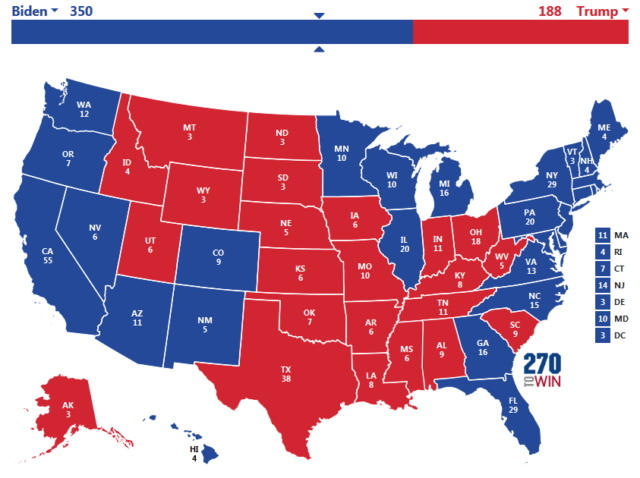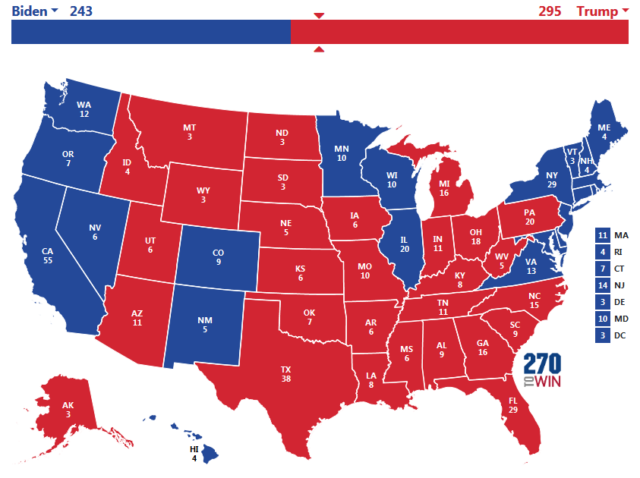I write this in the early afternoon of the Pacific Time Zone so the only true data I have to work with at present is the 16 votes for Trump and 10 votes for Biden in New Hampshire, which is not exactly representative of the national vote.
For reference, here was my November 3, 2016 presidential election prediction, where I predicted Trump 295, Clinton 243 (actual: Trump 304, Clinton 227 and 7 protest votes). The big “value-added” to that prediction, which the vast majority of others did not predict, was the breakout in Michigan.
Although all elections claim to be unique, in a sense they can be predicted to some extent given the historical correlations that various interest groups have with the red team or the blue team affiliations. Analytical minds in the major political parties try to ascertain which nudges (i.e. payouts to marginal special interests) to make to generate a winning coalition of voters. You get the numbers associated with each group, plug them into a paper napkin formula, and then build the campaign around such messaging. In 2016 it was the revival of the rust belt vs. establishment backroom politics. Trump’s team basically knew what he had to do, and aimed for a target in plain sight and got his deserved victory. Clinton’s campaign was basically “I’m not Trump”.
In 2020, times have changed. While in 2017 to early 2020 Trump was fighting the civil war in the bureaucracy (consider that a significant portion of the public service is Democratic and just because you’re the top guy in the top seat doesn’t mean that you’ll actually be able to implement policy instantaneously) and fulfilling various campaign pledges, COVID-19 completely destroyed the obvious re-election campaign pitch of “Keep America Great” to something a bit more diffuse. In this respect, COVID-19 was a net negative for Trump not because of the administration’s response to it, but because it destroyed the messaging narrative of the re-election campaign. In regards to the actual COVID-19 response, similar to Canada, the national government has limited control over the situation while provinces/states have a significant ‘say’ on what happens on the ground, which the public interprets as a national matter.
We look at the polling data. If you believe the polling data, you get an electoral map looking something like this:
In addition, congress will go Democratic, with both the House and Senate receiving Democratic majorities.
The question is – is this polling data correct? If it is, then this isn’t even going to be close. Biden wins by a mile. Indeed, in terms of the popular vote, states like California overwhelmingly will go Democratic, to the point of skewing the nation-wide popular vote by some wild margin towards the Democrats. The only reason why a Republican in California should bother up to vote is if their congressional race is in contention, or if they wish to vote in a state-wide initiative.
What polling data does not capture very well is motivation. Almost everybody you survey claims they will be voting and in reality the number is around 55-60%. In elections where voters have the choice to not vote, it is just as important to model the cohort that vote versus those that do not.
From a more fundamental perspective, I ask what numbers of voters that voted for Donald Trump in 2016 would want to either sit this one out, or to vote Democratic – and the only people that would be in this category are the ones that believed all of the promises in 2016 (which they’d most likely turn into non-voters), or establishment Republicans that a restoration of the previous order (the Jeb Bushes, Mitt Romneys, Carly Fiorinas and the like). The first cohort is sizable; the second cohort would likely have not supported Trump in 2016.
On the flip side, there is evidence that the Republican coalition is expanding to include more of the ethnic voters (especially in the Latino/Black communities) and this has an impact in states like Florida, Arizona and Nevada. Indeed, these numbers are probably going to have a significant impact in states like Georgia, which marginally are polling Democratic this election.
Although impacted by COVID-19, you can also see that Trump has crowd-gathering abilities still, despite 4 years in office (which tend to depress voter enthusiasm, similar to how Obama’s re-election did not bring nearly the crowds that came in 2008). In fact, the crowds that still come to Trump rallies can only be described as insanely high – it is a politician’s wet dream to see such numbers coming (just imagine Trudeau trying to set something up like this). This is contrasted with Biden, where even the most positive videos released by the Democrats don’t show that much (Bernie Sanders was much more successful in this metric).
The choice of Joe Biden is as close to a paper candidate as it gets – the whole world knows that he is not mentally functioning at a regular capacity, and that he would basically be a regent. The VP selection did not perform very well in the campaign trail, despite hitting all of the ‘political correctness’ check-boxes. Essentially, this renders the election as a referendum on Donald Trump – vote Democratic if you don’t like Trump, vote for Trump if you do. Are there more people upset with his presence today than they were in 2016?
Putting a long story short, to answer the original question, I believe the polling is skewed because they are not sampling the right cohorts. Here’s my guess, and it is awfully similar to 2016’s electoral map and projection:
The one state I would focus on for the Latino vote is Nevada – if the vote is relatively close (it was 47.9% Democratic and 45.5% Republican in 2016) then this state could potentially flip.
Unlike 2016, I have no money directly on the result of this election. The value received is too thin (Trump is +189, Biden is -215), compared to 4 years ago where Trump was being given away at +800 after the revealing of his politically incorrect comments.
Market-wise, no matter who wins, things are going to be in extremely rough shape. There will be a limit to the borrowing power of the US Government, and there will be a day of financial reckoning which will be extremely painful. An all-Democratic congress and presidency would be the worst outcome, while a divided congress historically is the best outcome for stability, which the markets like. But don’t believe any of these pundits that believe that Biden or Trump will be the best for the stock markets – I’d be playing the safety card.


Definitely not an election worth putting money on! I’m going to go with a Biden sweep, based on the assumption that the poll wonks have tightened up their statistical models after the 2016 debacle.
Picking some numbers out of one of their hats: Biden 412, Trump 126.
Translating polling data into electoral results is another form of garbage in, garbage out. If the method used to capture the data is crap, then the projection from it will be garbage as well. I actually think circumstances regarding the accuracy of publicly published polling data in the USA has turned worse from 2016.
Intriguing! Would you like to elaborate? Keen to hear your thoughts on this.
I’ve been checking in all day. I knew you wouldn’t sit this one out. Last time around, you were brilliant. What you didn’t mention is that you’d picked Trump to win even before he won the GOP nomination.
I wouldn’t bet against your quality analysis this time around but I sure hope you’re wrong! No offense 🙂
My ‘certainty factor’ in this election is a lot less than it was in 2016, or definitely contrasted with the last BC Election where I thought the NDP would get 60 seats (they didn’t because the Greens did better than my own projection – didn’t publish any of that). Trump’s run a fairly muddied campaign, but given COVID-19 I won’t blame him for that. I don’t know what the heck Biden stands for other than being “not Trump”. I feel sorry more for the electorate than anything.
The congressional result will count for a lot more than the presidential result in the grand scheme of things. If you have a Trump presidency and Democratic congress, or a Biden presidency and a Republican-controlled Senate, there is a check and balance. Not so if the Democrats sweep everything.
So it seems that Biden becomes the President, while republicans gain majority in both Senate and House.
I think it’s projected that Democrats will keep the House.
Even if the result is not exactly what the projected electoral map was above, in light of the wildly erroneous polling in several key states (e.g. WI, MI, PA weren’t even supposed to be in play, let alone NV) I’d say objectively this was a substantively correct prediction. It looks like Biden will be given MI, WI, AZ, but NV and PA are going to be ridiculously close. This has Bush vs. Gore written all over it.
[…] my 2020 prediction was essentially correct. It doesn’t matter that Trump actually wins or loses the electoral […]